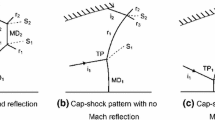Abstract
Numerical simulation of scramjet asymmetric nozzle flow is carried out to visualize and investigate the effects of interaction between engine exhaust and hypersonic external flow. The Single Expansion Ramp Nozzle (SERN) configuration studied here consists of flat ramp and a cowl with different combinations of ramp angle and cowl geometry. UsingPARAS 3D, simulations are performed for a free stream Mach number of 6.5 that constitutes the external flow around the vehicle. Appropriate specific heats ratio has been simulated for the jet and free stream flow. External shock wave due to jet plume interaction with free stream flow, the internal barrel shock wave and the shear layer emanating from the cowl trailing edge and sidewalls are well captured. Wall static pressure distribution on the nozzle ramp for different nozzle expansion angles has been computed for both with and without side fence. Axial thrust and normal force have been evaluated by integrating the wall static pressure. Effect of cowl length variation and side fence on the SERN performance has also been studied and found to be quite significant. Based on this study, an optimum ramp angle at which the SERN generates maximum axial thrust is obtained. SERN angle of 20° was found to be optimum when the flight axis coincides with nozzle axis.
Similar content being viewed by others
References
Berens, T., Numerical Investigation of Thrust Vectoring by Injection of Secondary Air into Nozzle Flows, AGARD Meeting on Computational and Experimental Assessments of Jets in Cross Flows, (1993-4).
Deere, K. A. and Asbury, S. C., Experimental and Computational Investigation of a Translating Throat, Single-Expansion-Ramp Nozzle, NASA TP 209138, (1999).
Panneerselvam, S., Ganesh Anavaradham, T. K., Geetha, J. J. and Thiagarajan, V., Review Document of Conceptual Design of Hypersonic Research Vehicle, No. DRDL. 5120.1004.000, (2001-12).
Spaid, F. W. and Keener, E. R., Experimental Results for Hypersonic Nozzle/Afterbody Flow Field, NASA TM 4638, (1995,3). User Manual for PARAS 3D, VSSC/TT/81/00, (2000-11).
Author information
Authors and Affiliations
Corresponding author
Additional information
Thiagarajan, V.: He received his B.Tech degree from Madras Institute of Technology, Chennai, India in 1990 and M.E. degree in Aerospace Engineering from Indian Institute of Science, Bangalore, India in 1992. His research interests are air-intake and nozzle aerodynamics for hypersonic air-breathing vehicle. He is currently pursuing his Ph.D degree at Indian Institute of Technology, Kanpur, India.
Panneerselvam, S.: He received his Ph.D degree from Indian Institute of Technology Madras, Chennai. He has contributed tremendously to the design and development of Indian guided missile programme. His research areas include missile aerodynamics, design and development of hypersonic air-breathing vehicle. Currently he is the Technology Director, Aerodynamics at Defence Research and Development Laboratory, Hyderabad, India.
Rathakrishnan, E.: He received his Ph.D degree from Indian Institute of Technology Madras, Chennai and currently is a professor of Aerospace Engineering at Indian Institute of Technology, Kanpur, India. He is well known internationally for his research in the area of jets, base flows and drag reduction. He is a fellow of Royal Aeronautical Society.
Rights and permissions
About this article
Cite this article
Thiagarajan, V., Panneerselvam, S. & Rathakrishnan, E. Numerical flow visualization of a Single Expansion Ramp Nozzle with hypersonic external flow. J Vis 9, 91–99 (2006). https://doi.org/10.1007/BF03181572
Received:
Revised:
Issue Date:
DOI: https://doi.org/10.1007/BF03181572




